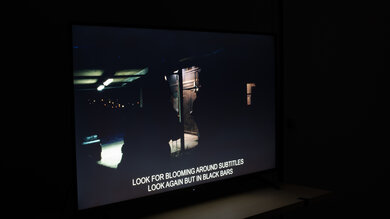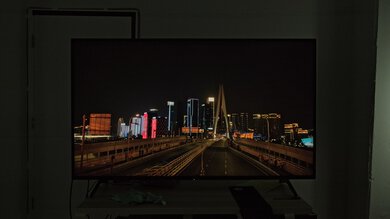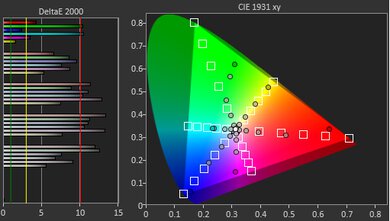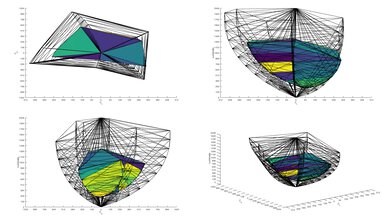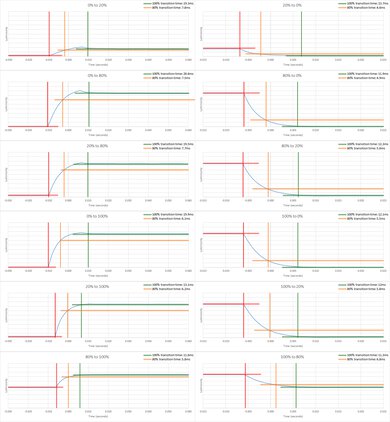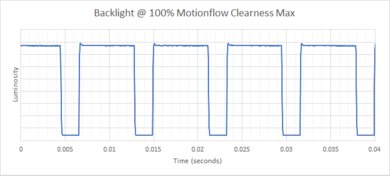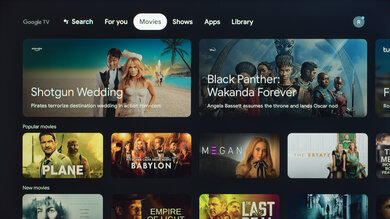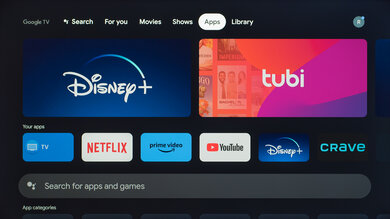The Sony X75K is an entry-level 4k TV released in 2022. It sits below the Sony X80K/X80CK, and mainly competes with other entry-level TVs like the TCL 5 Series/S555 2022 QLED, the Hisense U6/U6H, and the Samsung Q60B QLED. As an entry-level TV, it has very few extra features, but it offers the same great Google TV smart interface as the higher-end Sony TVs. It's powered by Sony's entry-level 4K Processor X1, and it offers a few motion enhancement features powered by Sony's 4K X-Reality PRO processor.
Our Verdict
The Sony Bravia X75K is a decent TV overall. It's best for watching shows or sports in a moderately-lit room, as it doesn't look very good in the dark due to its low contrast ratio and mediocre black uniformity. It has a wide viewing angle, making it a good choice for a wide seating area, as the image remains consistent from the sides. It's good for gaming thanks to its low input lag and decent response time, but it doesn't support any advanced gaming features. Sadly, it's unsuitable for use as a desktop PC monitor, as there's high input lag in the only mode that supports chroma 4:4:4, and there's a distracting pixel inversion issue with some content.
- No issues upscaling lower-resolution content.
- Image remains consistent from an angle.
- Satisfactory reflection handling and decent peak brightness to fight glare.
- Blacks are raised and look washed out.
- Can't smooth out low quality content.
The Sony X75K is a good TV for watching shows during the day. It has decent peak brightness in SDR and satisfactory reflection handling, so it can overcome some glare in a moderately-lit room. It also has a wide viewing angle, so the image remains consistent when viewed from the sides. The Google TV smart interface has a great selection of streaming apps, so you can quickly find your favorite content.
- No issues upscaling lower-resolution content.
- Image remains consistent from an angle.
- Satisfactory reflection handling and decent peak brightness to fight glare.
- Can't smooth out low quality content.
The Sony X75K is a decent TV for watching sports during the day. It has decent peak brightness in SDR and satisfactory reflection handling, so it can overcome some glare in a moderately-lit room. It also has a wide viewing angle, which is great for watching the big game with a group of friends, as you don't have to fight over the center seat. It has a decent response time, so fast-moving action is clear and easy to make out, and it has good gray uniformity with just a bit of dirty screen effect in the center.
- No issues upscaling lower-resolution content.
- Image remains consistent from an angle.
- Satisfactory reflection handling and decent peak brightness to fight glare.
- Can't smooth out low quality content.
- Backlight strobing feature can only flicker at 120Hz, causing duplications in motion.
The Sony X75K is a good TV for playing video games. It has fantastic low input lag, ensuring a very responsive gaming experience with little delay. It also has a decent response time, so there's just a bit of motion blur and ghosting behind fast-moving objects. It doesn't support a variable refresh rate, though, and it's limited to 60Hz, so it can't take full advantage of the new-gen consoles and you'll see some screen tearing.
- Low input lag for a responsive gaming experience.
- Satisfactory reflection handling and decent peak brightness to fight glare.
- No advanced gaming features like variable refresh rate support.
- No Auto Low Latency Mode.
- Limited 60Hz refresh rate.
The Sony X75K is okay for watching HDR movies in a completely dark room. It has low contrast and mediocre black uniformity, so dark areas of the screen look washed out. It can't display a wide color gamut for HDR content, either, and it doesn't get bright enough to bring out highlight details in bright scenes. On the other hand, it tracks the content creator's intent well, and it has decent gradient handling in HDR.
- Very little stutter in slow panning shots.
- Excellent PQ EOTF tracking.
- Can't remove judder from any source.
- Blacks are raised and look washed out.
- Low peak brightness in HDR.
The Sony X75K is a decent TV for gaming in HDR, but mainly for its gaming performance. It has fantastic low input lag, ensuring a responsive gaming experience, and there's just a bit of motion blur behind fast-moving objects. HDR adds very little overall, as it can't display a wide color gamut and it's not bright enough to bring out bright highlights.
- Low input lag for a responsive gaming experience.
- No advanced gaming features like variable refresh rate support.
- Low peak brightness in HDR.
- No Auto Low Latency Mode.
- Limited 60Hz refresh rate.
Unfortunately, the Sony X75K is unsuitable for use as a PC monitor, but it's good for gaming on a PC. It can only display chroma 4:4:4 properly in the 'Graphics' mode, which has very high input lag so your mouse movements feel sluggish. If you choose not to use 'Graphics' mode you can get low input lag, but there's a pixel inversion issue on one side of the screen that makes it difficult to read text from a PC. If you're just gaming, it has low input lag in 'Game' mode, and its wide viewing angle ensures the sides of the screen remain uniform when you're sitting up close.
- Image remains consistent from an angle.
- Chroma 4:4:4 is displayed properly for clear text from a PC.
- Satisfactory reflection handling and decent peak brightness to fight glare.
- High input lag in 'Graphics' mode.
- No advanced gaming features like variable refresh rate support.
- Pixel inversion issue with certain signals from a PC.
Changelog
- Updated Aug 28, 2023: We bought and tested the Sony X77L/X77CL, and added a few relevant comparisons below.
- Updated Aug 23, 2023: We corrected a mistake in our Pre Calibration and Post Calibration results. This TV has a 10-point white balance calibration system, not a 22-point.
- Updated Apr 28, 2023: Converted to Test Bench 1.11. With this update, we've added a new Upscaling: Sharpness Processing test and revamped our Blooming test so the scores and picture better match the real world experience. With this change, it was necessary to remove the Black Crush test. Finally, we've updated our usage scores to better align our scores with user expectations.
- Updated Apr 04, 2023: We retested judder on this TV and found that, unfortunately, it can't remove judder from any source, regardless of the motion interpolation settings used.
Check Price
Differences Between Sizes And Variants
We bought and tested the 65-inch Sony X75K, and these results are also valid for the 55-inch model. It's also available in a 43 and 50-inch size, but not in North America.
| Size | Model Number |
|---|---|
| 43" | KD-43X75K |
| 50" | KD-50X75K |
| 55" | KD-55X75K |
| 65" | KD-65X75K |
The unit we bought and tested was manufactured in November 2022. You can see the label for it here.
Popular TV Comparisons
The Sony X75K is a very basic TV that delivers disappointing picture quality for a Sony TV and offers very few extra features. It's okay if you don't care about gaming and aren't in a dark room, but you can get TVs with more features for less from other brands, including the Hisense U6/U6H or the TCL 5 Series/S555 2022 QLED. It's surprisingly still better than some of the newer budget Sony TVs, like the Sony X77L/X77CL.
See our recommendations for the best smart TVs, the best TVs under $1,000, and the best 4k TVs.
The Sony X77L/X77CL is a bit worse than the Sony X75K. The X77L has worse contrast, lower peak brightness, and worse gradient handling. It also has a slower response time, especially in shadow details, resulting in more noticeable black smear in dark areas of the screen.
The Sony X80K/X80CK is a bit better than the Sony X75K, although the differences are extremely minor. The Sony X80K has a much wider color gamut and better tone mapping, so HDR content looks more vivid and lifelike overall, and it can remove judder from 24p sources, while the X75K can't. There are a few issues with the X75K, including a pixel inversion issue with certain patterns, and it has high input lag in the only picture mode that can display chroma 4:4:4 signals properly, so it's unsuitable for use as a PC.
The TCL S555 is better than the Sony X75K. The TCL has a full-array local dimming feature that helps it deliver a much better dark room experience, with deeper blacks and better uniformity. The TCL also gets significantly brighter, so it can handle more glare in a bright room, and bright highlights in HDR stand out better. Finally, the TCL is better for gaming thanks to its faster response time and variable refresh rate support, so you'll see less blur behind fast-moving objects and less screen tearing.
The Samsung AU8000 and the Sony X75K are similar TVs, but the Sony is slightly better in a few ways. The Sony is a bit better for gaming due to its quicker response time, so you will have less blur behind quick moving objects, and it also supports 1440p gaming. The Sony gets brighter in SDR, so it overcomes glare in a bright room better than the Samsung. The Sony also gets brighter in HDR, so highlights pop a bit more with HDR content than the Samsung. Finally, the Sony has a wider viewing angle which makes it the better choice for watching TV with friends, as the image doesn’t degrade nearly as fast from the sides as the Samsung.
Test Results

This TV isn't part of our 100 TV accelerated longevity test.
The v-shaped feet are thin and support the TV well, allowing for just a bit of wobble forwards and backward. They're close to each end of the TV, so you'll need a wide table if you're not planning on wall-mounting the TV. Combined with the thick bezels, the feet give you about three inches between the table and the first pixels, so pretty much any soundbar will fit in front of it without blocking the screen.
Footprint of the 65-inch stand: 45.4" x 13.2".
The back is very plain, with a thicker section at the bottom that houses the TV's electronics and inputs, and a thinner top half. Most of the inputs face to the side and are easily accessible.
There are clips on the feet that provide very basic cable management.
This TV doesn't have a local dimming feature; the entire backlight is always on at the same intensity, so there's no distracting flicker or brightness changes as bright highlights move across the screen.
Unfortunately, the Sony X75K has mediocre peak brightness in HDR. There's very little variation in brightness with different scenes, and bright flashes and highlight details don't stand out at all due to the lack of local dimming.
These measurements are after calibrating the HDR white point, with the following settings:
- HDR Picture Mode: Custom
- Backlight: Max
- Contrast: 90
- Color Temperature: Expert 1
There's no difference at all in brightness when switching to 'Game' mode.
These measurements are after calibrating the HDR white point, with the following settings:
- HDR Picture Mode: Game
- Backlight: Max
- Contrast: 90
- Color Temperature: Expert 1
The Sony 65X75K has excellent PQ EOTF tracking, ensuring that most content is displayed at the brightness intended by the content creator. Like most LCD displays with no local dimming, near-blacks are raised a bit. Midtones are displayed well, and there's a gentle curve close to the TV's peak brightness, so fine details in bright scenes are preserved. There's no difference in EOTF tracking with different mastering levels, ensuring a consistent experience regardless of how the content was created.
This TV gets decently bright in SDR. It's bright enough to overcome a bit of glare in a moderately-lit room and there's no noticeable variation in brightness with different scenes.
These measurements are after calibration with the following settings:
- Picture Mode: Custom
- Backlight: Max
- Contrast: 90
- Color Temperature: Expert 1
This TV has an okay color gamut. It can't display a wide color gamut for HDR content, so overall there's not much difference in color saturation between SDR and HDR. The tone mapping is really bad with content mastered at high brightness levels (75% stimulus), but it looks a lot better with content mastered at more moderate levels (50% stimulus).
Unfortunately, this TV has just passable color volume. Colors are bright and stand out as well as pure whites, but it's limited by its narrow color gamut. It can't display dark, saturated colors either due to its low contrast ratio.
Even out of the box with just a few adjustments, this TV has amazing accuracy in SDR. Saturated reds are a bit off, and bright scenes are a bit too bright, but other than that, there are no noticeable issues. The color temperature is a bit cool, but it's not bad.
The calibration system on this TV is a bit limited, and it wasn't possible to fully correct everything as it lacks a color calibration system and the white balance calibration system is a bit sensitive. It still looks fantastic, though, thanks to its amazing accuracy before calibration.
You can see our full calibration settings here.
The Sony X75K has good gray uniformity. There's relatively little dirty screen effect, which is great for watching sports. The sides of the screen are significantly darker than the center, though, and this is more noticeable with regular content. The uniformity in near-black scenes is a lot better.
The Sony X75K has a great viewing angle. It's a good choice for a wide seating arrangement or if you like to walk around with the TV on, as the image remains consistent when viewed from the sides. Colors hardly shift, but the image fades a bit at a wide angle.
Gradients in HDR look decent. The biggest issues are with dark shades of gray, green, or blue. There's noticeable banding in bright greens, too.
This TV has an RGB subpixel layout, which is better for PC use than BGR panels because it improves the text clarity, which you can read about here.
This TV has an optional backlight strobing feature, commonly known as black frame insertion, to improve the appearance of motion. It can only flicker at 120Hz, though, which causes image duplications with 60 fps content.
Due to the relatively slow response time there's very little stutter. It's still a bit noticeable with slow panning shots, but it's good overall.
Unfortunately, this TV can't remove judder from any source, including native 24p sources like a Blu-ray player or a streaming device with a 'Match Frame Rate' feature.
Unfortunately, this TV is limited to a fixed 60Hz refresh rate; it doesn't support any variable refresh rate features like FreeSync.
This TV has fantastic low input lag for a responsive gaming experience, but only in the 'Game' Picture Mode. Unfortunately, the only picture mode that also supports chroma 4:4:4 for clear text from a PC also has incredibly high input lag, so mouse movements feel sluggish.
The Sony X75K has decent support for different resolutions. Chroma 4:4:4 is displayed properly with 1080p and 4k signals, but only in the 'Graphics' Picture Mode. Unfortunately, outside of graphics mode the TV can't display certain complicated patterns on the right side of the screen. It's not noticeable in most regular content outside of a desktop PC, and from a PC 'Graphics' mode works properly. You can see a few examples of the pixel inversion issue below.
Unlike higher-end Sony TVs like the Sony X90K/X90CK, the Sony X75K isn't part of Sony's "Perfect for PS5" lineup, and it doesn't support Sony's Auto HDR Tone Mapping or Auto Genre Picture Mode features. This means that you'll have to manually switch to the 'Game' Picture Mode for low input lag when you start gaming.
This TV has very limited gaming features, so it can't take full advantage of the Xbox Series S|X. It doesn't support Auto Low Latency Mode, so you'll have to manually switch to the 'Game' Picture Mode for low input lag when you start gaming.
Unlike most modern TVs, this TV has a full-sized composite input, no adapter required, which is great if you have older devices, including some older game consoles.
Unfortunately, although this TV supports eARC, it doesn't support any DTS formats, which is disappointing as DTS is often used as the main audio track on Blu-ray movies.
The Sony X75K has a decent frequency response. The sound profile is well-balanced, so dialogue is clear and easy to understand. It gets very loud, but there's noticeable compression at max volume, especially in the treble range. Like most TVs there's very little thump or rumble to its bass.
This TV has just okay distortion performance. There's very little distortion in the audible range at normal listening levels, but it increases dramatically at max volume.
Sony TVs, including the Sony X75K, still come with a full sized remote, which is rare. The remote is easy to use, and it has a built-in mic for voice control. Voice controls support launching apps, searching for content, and even asking basic questions like the weather or what time it is.








